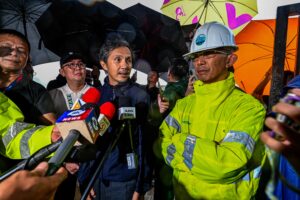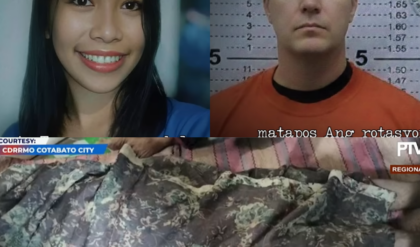Introduction: A New Era of Accountability in Public Works

In a clear and determined display of its commitment to reform, the Department of Public Works and Highways (DPWH) has formally filed criminal complaints before the Office of the Ombudsman (OMB) against a host of its own officials and private contractors. These charges stem from an intensive internal investigation that exposed rampant corruption in crucial flood control projects spanning two key regions: La Union in Northern Luzon and Davao Occidental in Mindanao.
Public Works Secretary Vince Dizon confirmed the filing, revealing a pattern of profound fraud involving what he bluntly termed “substandard” and “ghost” flood control projects. The seriousness of the allegations is reflected in the charges filed: Malversation of Public Funds through Falsification of Public Documents. This legal action is a direct response to the government’s mandate to clean up the agency and hold accountable those who have misused taxpayer money allocated for vital infrastructure.
The Nature of the Charges: Fraud and Falsification
The core of the complaints centers on the alleged criminal conspiracy between DPWH personnel and the contracting firms. By charging the individuals with Malversation of Public Funds through Falsification of Public Documents, the DPWH contends that officials intentionally manipulated records—such as completion reports, inspection forms, and payment vouchers—to certify projects as finished or meeting standards when they clearly did not. This falsification allowed the contractors to receive full payment, while public funds were essentially stolen, thus constituting malversation.
Secretary Dizon’s public statements have painted a grim picture of the offenses, highlighting a deliberate and widespread betrayal of public trust. The term “ghost projects” refers to infrastructure that was fully paid for but either does not exist or exists only on paper, while “substandard” projects refer to those built with inferior materials or workmanship that fail to meet specifications, yet were certified as complete and paid for in full.
The La Union Case: Substandard Works and Silverwolves

The corruption case in La Union centers on alleged anomalies within flood mitigation structures along the Bauang River Basin. The investigation revealed that two separate flood mitigation projects, each valued at a substantial , were both awarded to Silverwolves Construction Corp.
Secretary Dizon disclosed that during official inspections, these projects were found to be substandard, despite the fact that the company had already received full payment. This scenario suggests that the construction was intentionally compromised—likely using cheaper, inferior materials or failing to adhere to engineering standards—while DPWH officials facilitated the fraudulent certification of completion to enable the release of funds.
In relation to the La Union case, Dizon specified the exact count of the accused: “Twelve people were charged, plus the Silverwolves Corporation.” The officials implicated are likely personnel from the local District Engineering Office (DEO) involved in planning, materials inspection, and construction oversight, indicating a systemic failure that reached across various departmental sections. The sheer number of officials charged highlights the complexity and scale of the collusion required to fully pay for substandard works.
The Davao Occidental Scandal: Ghost Projects and St. Timothy Construction Corp.
The findings in Davao Occidental presented an even more alarming situation: a “ghost” flood control project valued at .
Dizon confirmed that this nonexistent project was awarded to St. Timothy Construction Corp. in January 2022. The term “ghost project” in this context is the gravest form of corruption, meaning the government paid nearly for a structure that was never physically built, or built only minimally, despite official documents claiming its completion.
Named prominently in the charges related to this case are the contractor, St. Timothy Construction Corp., and its owner, Cezarah “Sarah” Discaya. Discaya, as the head of the company, is directly linked to the alleged fraud involving the public fund loss.
In detailing the defendants for this province, Dizon stated: “Nine [people] for the Davao Occidental case, plus St. Timothy [Corporation] and Sarah Discaya.” The involvement of nine DPWH personnel suggests that, similar to La Union, a significant number of district officials were required to sign off on the project’s documentation, fraudulently verifying the existence and completion of the work to process the massive payment. The focus on the company owner, Sarah Discaya, demonstrates the DPWH’s intent to hold both the complicit public servants and the private individuals who benefited from the scheme fully accountable.
The Inspection Drive: A Zero-Tolerance Approach
These formal complaints are the direct result of an intensified inspection and reform initiative spearheaded by Secretary Dizon. The move to physically inspect sites and publicly call out anomalies signals a shift away from desk-bound administrative processing toward on-the-the-ground validation.
In the press conference, Dizon alluded to a “pattern of ‘ghost’ or ‘substandard’ flood control projects,” indicating that the cases in La Union and Davao Occidental are likely not isolated incidents but symptoms of a wider systemic issue within the agency. The public visibility of this reform effort reached a peak when previous reports detailed Dizon’s reaction upon inspecting the ghost project, where he reportedly cursed at the Davao DPWH District Engineer over the project, highlighting the deep frustration and severity of the discovery.
The inspections serve a dual purpose: gathering irrefutable evidence for the OMB complaints and sending a clear message to all DPWH district offices that the old practices of passive oversight and complicity will no longer be tolerated. By prioritizing on-site checks and publicizing the findings, the DPWH aims to restore public confidence in its processes and its commitment to delivering value for public money.
The Path Forward: Prosecution and Systemic Reform
The filing of these complaints before the Office of the Ombudsman is the initial, crucial step in the legal process. The OMB will now conduct its own investigation to determine whether there is probable cause to file criminal charges against the accused in the Sandiganbayan (the Philippine anti-graft court).
This move is part of a larger, systemic overhaul. The DPWH has also established collaborations with the Anti-Money Laundering Council (AMLC) to trace and recover the lost funds, and with the Philippine Competition Commission (PCC) to prevent bid rigging and ensure fair procurement in the future. These complementary actions show that the DPWH is not just punishing past crimes but is actively fortifying its internal systems against future abuse.
The case against St. Timothy Construction Corp. and Silverwolves Construction Corp., and the numerous officials involved in both La Union and Davao Occidental, is set to be a landmark legal battle. It symbolizes the government’s unwavering resolve to prosecute those who defraud the state, ensuring that funds intended to protect communities from devastating floods are actually used for their intended purpose. The success of these prosecutions will be a critical measure of the government’s seriousness in its commitment to transparency and integrity in public service.





